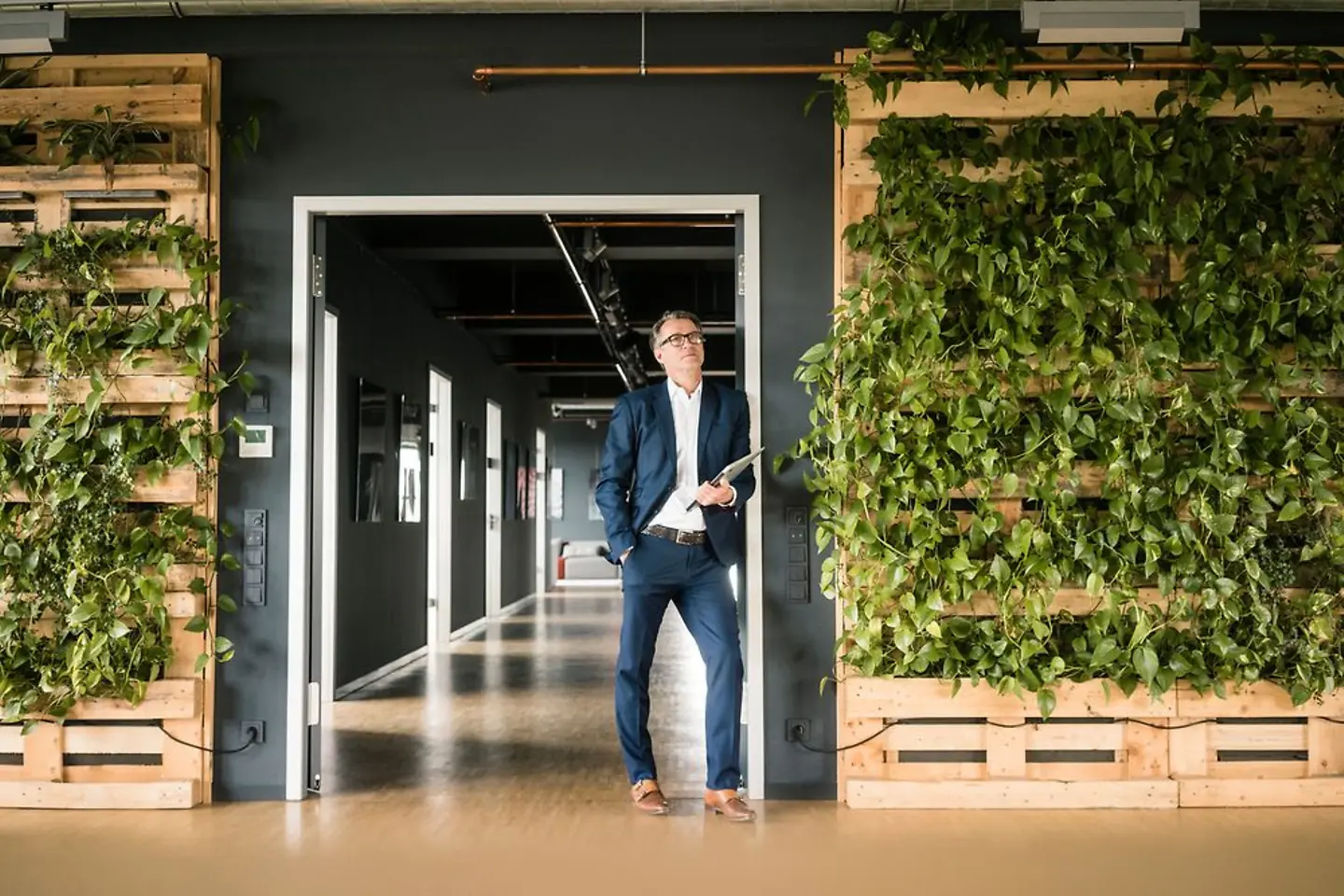
Do you know what contribution your IT can make to reducing your CO2 emissions? Unfortunately, the positive contribution of IT modernization often falls by the wayside when it comes to sustainability in business, and the opportunity to reduce the ecological footprint of the company's applications is squandered. Those who combine sustainability and cloud transformation and leverage them as a sustainability tool are at the cutting edge. Read how to achieve this here.

Companies are under pressure: They have to reduce their carbon footprint as quickly as possible – not only as a result of regulations, but also because their customers, employees, and investors expect them to do so. They are therefore scrutinizing each and every one of their business areas and looking for ways to improve their sustainability in the future. Most are taking the same approach as the large logistics service provider we recently advised: they are upgrading their vehicle fleets and logistics processes to be more environmentally friendly, refurbishing their buildings, and reducing the number of business trips. At first, our customer didn't think to optimize their IT with regard to sustainability when migrating to the cloud. This is not uncommon and really no wonder, as companies rarely have a clear idea of the environmental footprint of their data centers, servers, and applications.
My tip: If your company has a Chief Sustainability Officer (CSO), make sure that they are in regular dialog with your CIO. After all, if your business wants to be more sustainable, you must also protect the climate and the environment when operating your application landscapes. And if you are planning a cloud transformation, make sure to involve both experts in its implementation.
Pandemics, broken supply chains, geopolitical crises: In the last two years, many companies have found that their IT is too rigid to react flexibly to these kinds of unforeseen events. They want to become more agile and efficient, react more quickly and flexibly to changes in the market, and improve their customer experience. The solution? It's simple: the cloud. But be careful: Those who neglect the issue of sustainability in their cloud transformation risk having to readjust it later at considerable expense and effort. I am certain that companies will only stay competitive in the future if they embrace sustainability by design in their digital transformation. Sustainability will be a key point of distinction in the near future. Companies simply cannot afford to neglect the environmental footprint of their IT. My urgent appeal: use your cloud transformation as a sustainability tool.
Overall, digitalization saves up to ten times more energy than it consumes. It is therefore an important factor when it comes to not only agreeing on climate targets, but also complying with them."
Timotheus Höttges, Deutsche Telekom
I'm often preaching to the choir when I ask that at companies. Many of them are increasingly asking their service providers for sustainable IT solutions. They are assessing whether their sustainability profile fits their cloud strategy. What they lack, however, is an overview of how to initiate an ecological transformation in concrete terms. It's no surprise to me that, according to Google, about two thirds of executives would like to advance sustainability efforts but don't know how to go about it. There is still a lack of transparency, of simple tools and innovative technologies, and of data on the sustainability of IT. Management is usually only able to guess what the impact of its sustainability initiatives will be on the environment and the ecological footprint of their business. That's why we developed our SaaS solution Syrah Sustainability, which helps companies keep track of all sustainability indicators. All relevant data is collected and reported on a dashboard.
A study conducted by Microsoft found that cloud platforms such as Microsoft Azure are 93 percent more energy efficient and 98 percent more CO₂ efficient to use than on-premises solutions. We have carried out our own analysis, which involved migrating SAP applications from in-house customer data centers to our private cloud, and seen similar results: we were able to reduce CO2 emissions by more than 70 percent. But the math only adds up if we get the cloud transformation right. In cloud environments, it is not possible to separate the infrastructure from the applications. This means that in order to curb carbon dioxide emissions, we need to act on all levels. Sustainable software modernization starts with IT hardware and therefore invariably with choosing the right data center. Sustainable IT infrastructures ensure that resources are used carefully, energy consumption is continuously reduced, and these efforts can also be verified.
An IDC study estimates that global annual data traffic will increase to 175 zettabytes by 2025. That's a number with 21 zeros! And this growth is being fed primarily by cloud computing applications. For some time now, major cloud providers have been systematically streamlining their data centers for sustainability. My colleague Mirjam Warmsteeker reported on this recently. Providers such as Google make clear which of their data centers are particularly "green" in their cloud consoles. The region in which a data center is located, for example, affects its sustainability. Sustainable IT is also an advantage provided by T-Systems. We are systematically upgrading our data centers to run climate-neutral operations; our data centers in Magdeburg and Biere, for example, have been awarded the international LEED Gold certification (Leadership in Energy and Environmental Design) and are among the ten greenest facilities worldwide.
You can display all external content on the website at this point.
I agree that personal data may be transmitted to third-party platforms. Read more about this in our privacy policy.
The Open Telekom Cloud is the leading OpenStack-based cloud solution in Europe. It delivers the highest data security, maximum flexibility and personal support to over 100 million satisfied end users. From Europe, for Europe - for maximum data sovereignty.
You can display all external content on the website at this point.
I agree that personal data may be transmitted to third-party platforms. Read more about this in our privacy policy.
Sustainability in a digital world - Harness the power of digital to reduce your carbon footprint
#Carbon-free Production / Steffen Roos (Detecon) explains in his presentation at the HannoverMesse 2021 (organizer Deutsche Telekom) how a sustainable digitalization strategy can help companies on their own path to better climate compatibility and sustainability!
It is, however, clear to me that companies are unlikely to select cloud providers' data centers solely on the basis of sustainability considerations in the future too. A large number of parameters go into making this decision – such as price, data protection guidelines, and latency. We have been helping companies find the best possible compromise in their data center analysis for quite some time now using our Cloud Readiness Assessment. We make sure they know that sustainability is by no means a minor issue. After all, it's one that will come back to haunt us, and not just because employees, customers, and investors place great value on sustainability – but because regulations also apply to data centers. For example, the EU climate plan "Fit for 55" aims to reduce CO2 emissions on the continent by at least 55 percent by 2030 and develop a sustainability index for data centers.
Sustainable IT transformations involve the modernization of the application landscape. The cloud offers a variety of solutions for this.

Many of our customers are laying the foundation for achieving ambitious goals such as "zero emissions" or "net zero emissions" by modernizing their IT. And we can often support each other in the process. Not only is Shell a cloud customer, but we are also currently building 10,000 charging stations for e-cars in Germany for the mineral oil company. In return, Shell helped us install immersion cooling technology in one of our data centers in Amsterdam for greater computing power and energy efficiency. Sustainability is always a community affair. Left to their own devices, no company would be able to meet the challenges of climate change. Nor do they have to: Professional providers are lending a hand with cloud computing. They are better able to manage and make use of the resources in their data centers – after all, that is their core business.
But that core business is changing: Since the requirements for sustainable IT operations in Germany, the EU, and around the world are becoming increasingly stringent, optimizing CO2 emissions needs to become an additional discipline in IT. I am certain that we will soon be able to measure the emissions of IT in real time, and that we will be required to do so. For us as cloud providers, this means that we will be making heavy investments in new technologies and sustainable services in order to keep shifting the scales in the direction of sustainability. If you would like to delve further into the topic, I recommend the articles Are digitalization and sustainability compatible? and Be green, or cease to be? by Mirjam Wamsteeker. I would especially like to recommend the article by my colleague Christian Till Roga. Because he knows how to turn green words into green deeds. See you soon, your Manfred Rothemund.